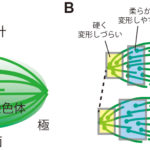2019-05-24 SpaceX
2019年5月23日木曜日の午後10時30分(東部標準時)。SpaceXは、フロリダ州ケープカナベラル空軍基地のSpace Launch Complex 40(SLC-40)から60個のStarlink衛星を打ち上げました。 SpaceXのStarlinkは、世界中をつなぐことができる次世代の衛星ネットワークです。特に、まだ接続されていない人には、信頼性が高く手頃なブロードバンドインターネットサービスを提供します。
Falcon 9のファーストステージは、以前は2018年9月のTelstar 18 VANTAGE任務と2019年1月のIridium-8ミッションで使用しており、大西洋に駐留していたドローン船“Of Course I Still Love You” に着陸した。 離陸後約1時間2分で、スターリンク衛星は高度440kmで展開されました。 それから彼らは550キロの運用高度に到達するために船内推進力を使用しました。
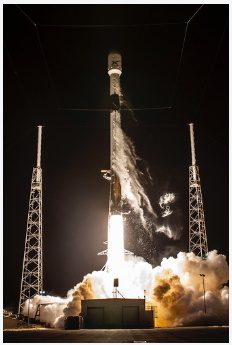
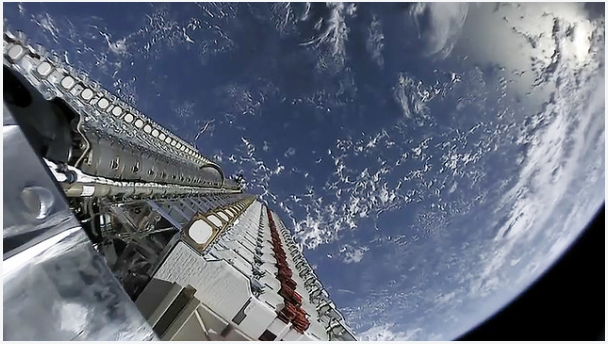
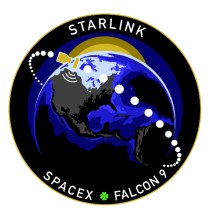
SpaceX is targeting Thursday, May 23 for the launch of 60 Starlink satellites from Space Launch Complex 40 (SLC-40) at Cape Canaveral Air Force Station, Florida. SpaceX’s Starlink is a next-generation satellite network capable of connecting the globe, especially reaching those who are not yet connected, with reliable and affordable broadband internet services. The launch window opens at 10:30 p.m. EDT on May 23, or 2:30 UTC on May 24, and closes at 12:00 a.m. on May 24, or 4:00 UTC. A backup launch window opens on Friday, May 24 at 10:30 p.m. EDT, or 2:30 UTC on May 25, and closes at 12:00 a.m. on May 25, or 4:00 UTC. Falcon 9’s first stage for this mission previously supported the Telstar 18 VANTAGE mission in September 2018 and the Iridium-8 mission in January 2019. Following stage separation, SpaceX will attempt to land Falcon 9’s first stage on the “Of Course I Still Love You” droneship, which will be stationed in the Atlantic Ocean. Approximately one hour and two minutes after liftoff, the Starlink satellites will begin deployment at an altitude of 440km. They will then use onboard propulsion to reach an operational altitude of 550km. SpaceX designed Starlink to connect end users with low latency, high bandwidth broadband services by providing continual coverage around the world using a network of thousands of satellites in low Earth orbit. To manufacture and launch a constellation of such scale, SpaceX is using the same rapid iteration in design approach that led to the successes of Falcon 1, Falcon 9, Falcon Heavy, and Dragon. As such, Starlink’s simplified design is significantly more scalable and capable than its first experimental iteration. With a flat-panel design featuring multiple high-throughput antennas and a single solar array, each Starlink satellite weighs approximately 227kg, allowing SpaceX to maximize mass production and take full advantage of Falcon 9’s launch capabilities. To adjust position on orbit, maintain intended altitude, and deorbit, Starlink satellites feature Hall thrusters powered by krypton. Designed and built upon the heritage of Dragon, each spacecraft is equipped with a star tracker navigation system that allows SpaceX to point the satellites with precision. Importantly, Starlink satellites are capable of tracking on-orbit debris and autonomously avoiding collision. Additionally, 95 percent of all components of this design will quickly burn in Earth’s atmosphere at the end of each satellite’s lifecycle—exceeding all current safety standards—with future iterative designs moving to complete disintegration. This mission will push the operational capabilities of the satellites to the limit. SpaceX expects to encounter issues along the way, but our learnings here are key to developing an affordable and reliable broadband service in the future.
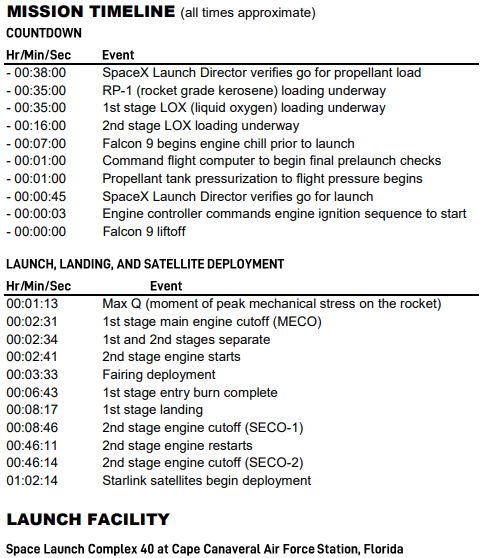
SpaceX’s SLC-40 at Cape Canaveral Air Force Station is a world-class launch site that builds on a strong heritage. The site, located at the north end of Cape Canaveral Air Force Station, was used for many years to launch Titan rockets, among the most powerful in the U.S. fleet. SpaceX took over the facility in May 2008. The center of the complex is composed of the concrete launch pad and flame diverter system. Surrounding the pad are propellant storage tanks, four lightning towers, and the integration hangar. Before launch, Falcon 9’s stages and payload are housed inside the hangar. The payload is mated to the Falcon 9 inside SLC-40’s hangar on the transporter erector. The rocket and payload are then rolled out from the hangar to the launch pad and lifted to a vertical position.



